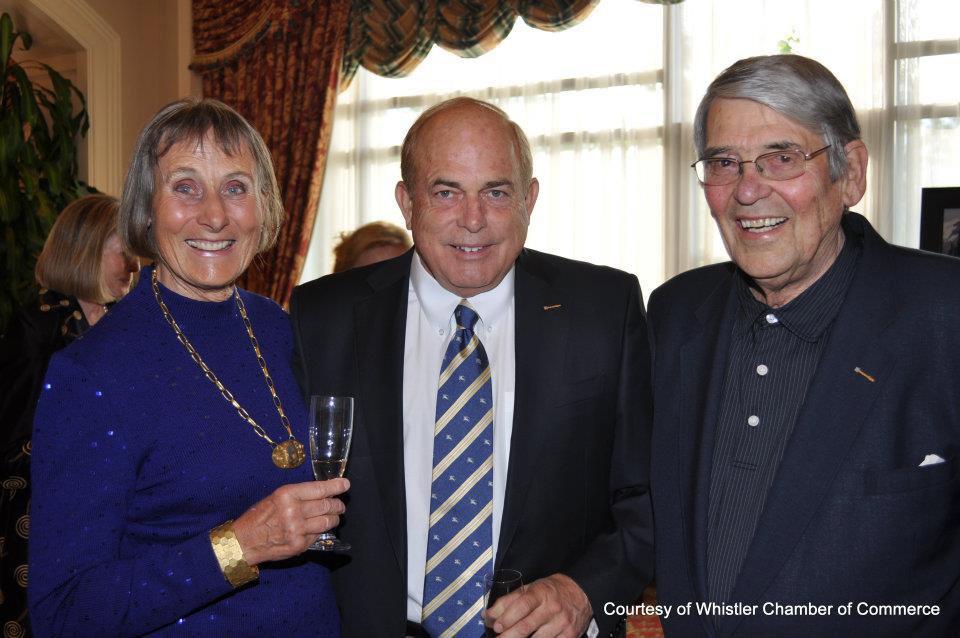Newly-minted Canadian Ski Hall of Famers Paul Mathews and Peter Alder are two men responsible for helping create the Whistler that is enjoyed by millions of visitors each year, but building one of the world’s top ski resorts wasn’t always on top of their respective to-do lists.
When Alder first arrived in the Sea to Sky corridor from Switzerland in the 1950s, his workdays were spent stringing power lines between Bridge River and Squamish.
It would be a decade until he became the ski-area manager of Red Mountain, near Rossland, in 1962, before moving on to Silver Star, Big White, and eventually to Whistler in 1978, when he was appointed GM and vice president of Garibaldi Lifts Ltd.
At around the same time Alder was managing resorts in B.C.’s Interior and working to establish the first Ski Area Management course at Castlegar’s Selkirk College, Mathews was in Whistler dreaming of how he could build a career designing ski resorts at a time when the trailhead to that career path didn’t exist.
Born in Denver, Mathews had arrived in Whistler in the late ’60s, heading north in search of snow after moving to Washington with his family and swiftly discovering Snoqualmie Pass didn’t measure up to the terrain he was used to skiing back in Breckenridge.
“I looked at the blue skies and the snow we have here and I was smitten,” Mathews remembered. “I just decided Whistler was going to be my home. I was a ski bum for a few years, skied 120 days a year, then said, ‘Well, I gotta find a profession [that will allow me] to live up here.”
There was certainly no post-secondary course for resort design, Mathews added, meaning he “had to sort of patch together [a degree]” himself.
Hugh Smythe, who moved to Whistler in 1966 at the age of 19 to work as a ski patroller and went on to become president of Blackcomb and then Intrawest Resort Operations Group, still remembers his response when Mathews told him about his plans to study forest ecology and landscape architecture at Washington State University in hopes of becoming a ski-area planner.
“I said to him, ‘Are you nuts?’” Smythe recalled.
“It was an impossible dream,” Mathews acknowledged. Still, Mathews would go on to become an expert in sustainable planning, purchasing a business license for $1 in 1975 to become one of the newly-incorporated Resort Municipality of Whistler’s first businesses. That venture was Ecosign, now the world’s leading ski resort design firm.
As for Smythe? “He ended up being my best customer, probably,” Mathews said with a laugh.
Smythe also served as the catalyst for both Mathews’ and Alder’s inductions this month to the Canadian Ski Hall of Fame and Museum (CSHFM). Inducted into the CSHFM himself in 2010, Smythe nominated the two Whistlerites individually in the “builder” category.
Sadly, Mathews was the only one on hand to receive the honour himself. Alder earned the accolade posthumously, following his death in July 2021 at the age of 91. His wife Trudy and two sons, Rick and Doug, accepted on his behalf.
Though both left an immeasurable mark on Whistler, their contributions to the ski industry extend far beyond the resort’s boundary ropes.
Under the Ecosign umbrella, Mathews has overseen the master plans for Whistler Mountain since 1976 and Blackcomb Mountain since 1986, was responsible for the design of six Olympic venue sites, developed Sun Peaks, and was the mastermind behind the merging of Zermatt, Switzerland’s five competing lift operators in 2002.
Still, among the hundreds of other projects Ecosign has completed in 46 countries and six continents, the development of his home mountains will always be one Mathews most cherishes.
“We first became the biggest [resort] in Canada, but then we became, without question, the biggest in North America,” he said. “The guys at Vail used to say, ‘Oh no, that’s actually two separate ski areas, you’re not one resort’—you know, trying to cut our numbers—but when we put up the Peak 2 Peak, they had to shut up.”
Alder, meanwhile, initiated the first-ever ski-area master plan for Whistler Mountain, including the north-side lifts that would eventually service the sparkling new Whistler Village in 1980, serving as then-Blackcomb manager Smythe’s “arch competitor,” he joked.
Alder “was rightfully regarded as a founding father of the ski industry in British Columbia,” Smythe wrote in the nomination form. “Very few people were as deeply involved, for so long and at so many levels, as Peter was over his lifetime.”
Mathews’ and Alder’s paths converged several times over the years, in particular when Alder joined Ecosign as a consultant following his retirement, helping the firm move into the European ski industry. “I’ve had many, many mentors from the ski business. One of the oldest and most trusted has been Peter Alder,” Mathews said in his acceptance speech.
Though Alder’s work in the ski industry was an important part of his life, “there was another side of him that not everyone knew,” his son Doug said during the ceremony.
“His curiosity combined with a fearlessness meant that he would talk to everyone. He made people feel valued and special and it seemed that he was often helping someone get a job, a loan, open a business, figure out a career. I think this induction into the Canadian Ski Hall of Fame class of 2022 would have brought a tear to Peter’s eye, to be recognized in this way.”





